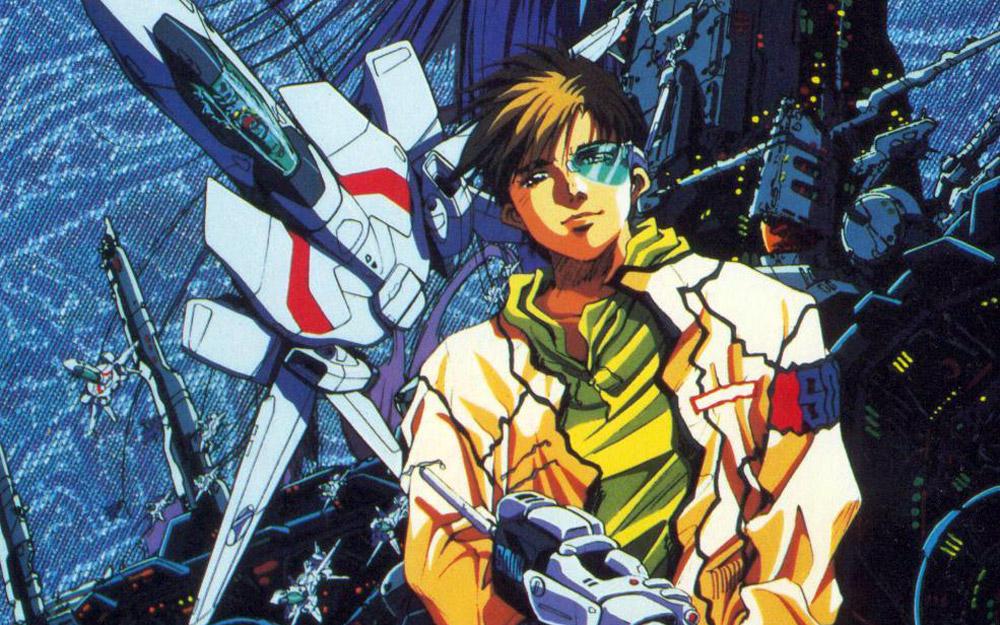
The entire time I watched Macross II, I couldn’t help but wish I was watching the far superior Macross Plus. Compared to the drama and action in that movie, Macross II felt like a cheap knockoff. But most Macross fans consider Macross II to be somewhat of an anomaly anyways. But looking at the official Macross timeline, you quickly realize a few things. First of all, the original Macross creators had nothing to do with Macross II, and second of all, it was intended to be a sequel to Do You Remember Love?, a “historical” movie based upon the events in the “real” Macross timeline. Yeah, it took me a couple tries to understand that logic too.
Hibiki Kanzaki is a hotshot reporter at the Scramble News Network (SNN). When he reports on a seemingly scandalous story involving top-ranking officers at U.N. Spacy, Earth’s military organization, he’s quickly chastised. However, when mysterious aliens start attacking Earth, he gets a chance to redeem himself. Teamed up with Dennis Lone, SNN’s veteran war correspondent, he discovers that U.N. Spacy’s forces are not sufficient enough to defend against the new threat.
Sneaking aboard one of the alien vessels, Hibiki and Dennis discover Ishtar, a mysterious alien female. Believing that she might be able to answer some questions about the new aliens. When Dennis is killed during their escape, Hibiki is determined more than ever to get out the truth. But when U.N. Spacy censors all of the media to cover up their weaknesses, Hibiki decides that Ishtar holds the key to getting the truth out. Ishtar, however, is bombarded by the new culture around her. Her race, the Marduk, know only war and violence, but on Earth, she experiences peace for the first time. It’s also here that she discovers the Macross space fortress (SDF-1 to you Robotech geeks), which she believes to be the Alus, a legendary vessel that will bring peace to her people.
Hibiki finds himself falling for Ishtar, but all for naught. Needless to say, the Marduk show up to reclaim Ishtar, who turns out to be a priestess necessary for their military strength. In order to preserve the new life she’s found, Ishtar agrees to return to the Marduk. Hibiki, with the aid of U.N. Spacy’s top ace, Sylvie Gena, heads off to rescue her. Together, the three of them must use the Macross to defend the Earth from the combined might of the Marduk and their Zentraedi slaves.
Since many might construe this as a Macross sequel, it should be compared to Macross Plus, which is largely viewed as the “official” sequel to Macross. And in every possible way, it’s found lacking. Macross II’s characters never feel fleshed out enough to be believable. As such, there’s no real drama in Macross II. Macross Plus, on the other hand, is driven by its human drama; at its root, it’s a tragedy and riveting as such.
Macross II’s animation feels especially cheap and shoddy, lacking the flair and drama of Macross Plus. This is especially true in the battles. In Macross II, they’re confusing and muddled. In Macross Plus, they always seem fresh and action-filled, in spite of repeated viewing. Granted, Macross II has some pretty mecha designs, especially the Valkyries. Too bad they’re rendered so poorly much of the time. And musically, the Macross Plus’s score, courtesy of Yoko Kano, walks all over the cheesy Wilson Phillips stylings of Macross II’s soundtrack.
If you’ve got a few spare bucks and two hours to kill, Macross II might be worth a rental. But if you really want to experience the drama and quality that the Macross series is capable of, get Macross Plus instead.